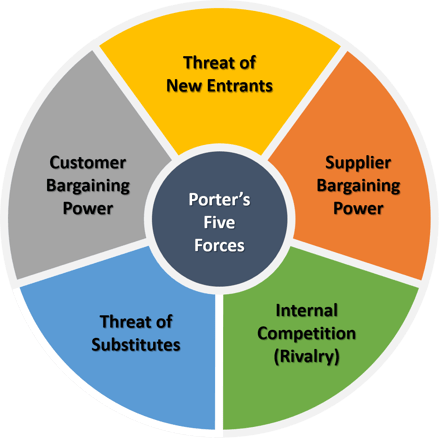Porter’s analysis is a framework that helps analyzing the level of competition within a certain industry. It analyses five competitive forces that shape every industry and helps determine an industry's weaknesses and strengths. When we are starting a new company or when we are entering a new industry, Porter’s Model comes to use.

History Of Porter’s Five Force Framework:
Michael E Porter of Harvard Business School developed the model in 1979. Originally, this was Porter’s first article for the Harvard Business Review. His goal with the Five Forces Model was to provide a new way to use effective business strategy to identify, analyse and manage external factors in an organizations environment.
Porter’s Five Force Framework:
The Five force model consist of
- Supplier Bargaining Power
- Customer Bargaining Power
- Threat Of New Entrants
- Threat Of Substitutes
- Competitive Rivalry
Supplier Bargaining Power:
- The bargaining power of suppliers comes into effect since suppliers supply the raw material needed to provide a good or a service.
- This means that typically there is a need for businesses to maintain strong and consistent relationships with their suppliers.
- Supplier power is at its peak generally when there are less suppliers in an industry.
- This makes costs of switching to an alternate high or perhaps there are no alternates.
Some threats posed by suppliers are number of suppliers, size of suppliers, supplier concentration, switching cost for supplier’s products etc.
Customer Bargaining Power:
- The bargaining power of customers occurs when buyers have the power to affect prices in a given industry and becomes an important consideration for a company.
- Customers tend to have the most power over an industry if they are important to the company such as being a bulk buyer or being able to easily switch to another supplier.
Some of the threats posed by customers are price sensitivity, switching for substitutes, information availability etc.
Threat Of New Entrants:
- The competitive threat to a company’s business and operations may be increasingly in the form of new entrants as opposed to existing competitors.
- New entrants into an industry are very prominent when the industry is profitable and attractive.
Some of the threats posed by new entrants are product differentiation, access to latest technologies, experience and learning effects etc.
Threat of Substitutes:
- The threat of substitutes consists of different and substitute products that exist in another industry but may be used to fill the same need.
- Overall, the more substitutes that exist for a product, the larger a company’s competitive environment and the likelihood of lower profits.
Some of the threats posed by substitutes are number of substitutes available, price performance of substitutes, switching cost etc.
Competitive Rivalry:
- Competitive rivalry is the degree of competition between existing companies in the same market.
- Generally, if more companies are competing with each other, the resulting competitive press means that prices, profits and strategy will be driven by it.
Some of the threats posed by competitive rivalry are number and diversity, quality difference, brand identity etc.
Let us consider a simple example of implementing Porter’s five force in rea life.Let us say you want to start a soft drink’s company.
- Supplier Bargaining Power: Raw materials
- Customer Bargaining Power: Cheaper product with better quality
- Threat Of New Entrants: New innovative entrepreneurs with cost effective ways
- Threat Of Substitutes: Companies with better amenities to produce better and lower cost
- Competitive Rivalry: Giants like Coco Cola, Pepsi etc.
Advantages of Porter’s Model:
- Dealing with Buyers and Suppliers
- Helpful in Planning
- Helps in Gauging Competition









